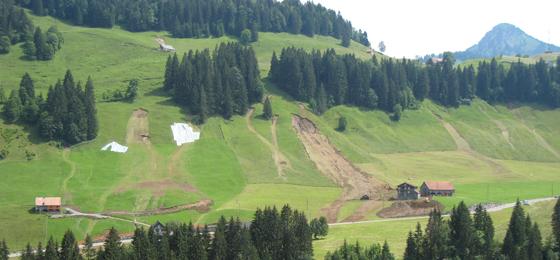“Soil stability” project completed

Landslides pose a constant threat to humans, buildings and infrastructure. Properly adapted management of endangered areas and the use of suitable combinations of plants and mycorrhizal fungi help to reduce the probability of landslides.
Shallow landslides can cause damage totalling more than CHF 100 million in a single weather-related event, and can even claim human lives. The aim of the “Soil stability” project conducted by Frank Graf (SLF) and his project team was to more reliably quantify the effects of vegetation on slope stability. To this end, biological stabilisation effects were linked with soil-mechanics parameters. In addition to plants – in particular trees – mycorrhizal fungi also play a key role in the biological stabilisation of soils vulnerable to landslips, both directly through their contribution to soil aggregate stability and indirectly by promoting plant growth. With regard to forest cover, a gap length of more than 20 metres along the fall line can adversely affect the stability of slopes. By contrast, the breadth of such gaps is of lesser importance. Species-rich forests with a varied root structure, total cover of more than 60% and good variety of tree height and age structure contribute to slope stability. Our investigations of root-permeated soil indicate that correspondingly planted slopes can stay stable at inclinations up to 5° steeper as is admissible from a geotechnical perspective for fallow soil.
Since high nutrient inputs and soil compaction impair the stability of slopes, intensive agricultural use or grazing should be avoided within or above areas with a high probability of landslides. Where landslides have already occurred, replanting and stabilisation of slopes using biological engineering techniques should also take account of mycorrhiza fungi, especially in combination with plants that had been present originally. Based on the exceptional flood event that occurred at Sachseln in 1997, it was calculated that investments equivalent to approximately 10–25% of the damage incurred (approx. CHF 120 million) were needed to manage the forest in such a way as to provide optimal protection against shallow landslides. Investigations in other areas will be needed to demonstrate the actual protective effect of forests that are managed and maintained in this way. If the results from Sachseln prove correct, annual investments of around CHF 300–800 per hectare would appear to be extremely worthwhile in the long term for providing the best possible protection against shallow landslips.
- Project Soil stability
- Executive Stakeholder Summary (available in German or French only) (PDF)
- Project page of SLF
